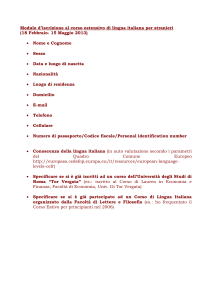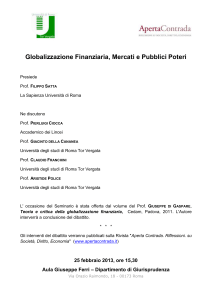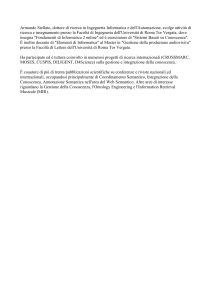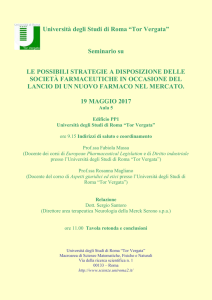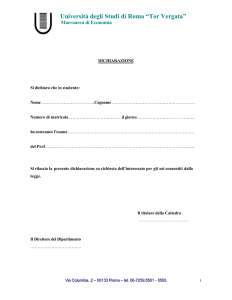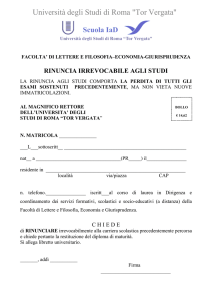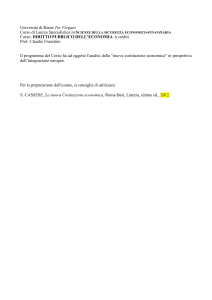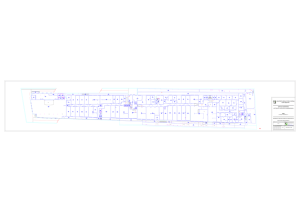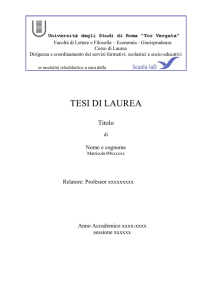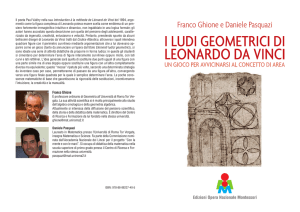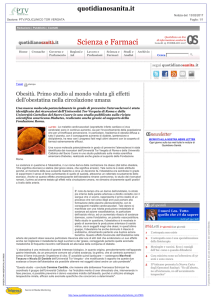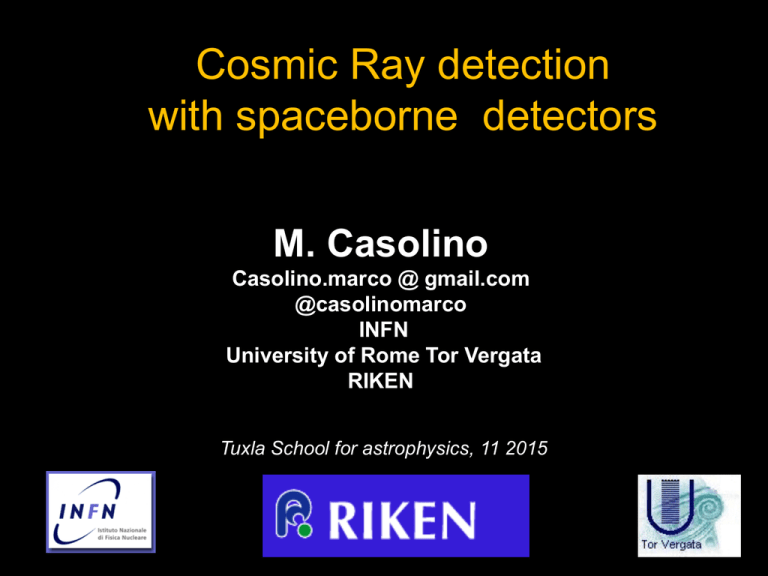
Cosmic Ray detection
with spaceborne detectors
M. Casolino
Casolino.marco @ gmail.com
@casolinomarco
INFN
University of Rome Tor Vergata
RIKEN
Tuxla School for astrophysics, 11 2015
15/8/2011
7. Dark and Anti-Matter
Dark Matter
Most probably a particle
Does not emit or absorb light
Does not interact e.m. or strong.
Should be „transparent‟ matter
Interacts gravitationally
Most probably interacts weakly
When dark matter?
In 1933 Zwicky, observing the
movement of galaxies in the Coma
cluster understood that their visible
mass was not enough to keep them in
a bound state.
He estimated that not visible mass
should have been at least 160 times
the galaxies
Immagine a falsi colori: blu – visibile (Sloan Digital Sky Survey)
Rosso e verde - Infrarosso (NASA's Spitzer Space Telescope)
…noone listened…
Fritz Zwicky
14/2/1898, Varna (Bulgaria)
8/2/1974 Pasadena
Dark matter inside the galaxies
1959: Louise Volders
showed that spiral
galaxy M33 does not
rotate as expected.
Stars in the galactic
arms should follow
keplerian law, since
most of the mass was
thought to be
concentrated in galactic
center
Rotation speed (km/s)
Galaxy rotation curve
Observed experimentally
Predicted by
keplerian law
Distance from galactic center (kpc)
Doppler shift in the
21 cm (hyperfine
line)
Back to cluster of galaxies
• X-ray emission from
Hydrogen gas falling in
the gravitational well of
galaxy clusters
• Visible barion fraction:
0.56%
fBh3/2=0.0560.014
• Matter from Big Bang:
38%
Wmatterh1/2=0.380.07
Gravitational lensing
Distorsione dello Spazio - Tempo
R
1
g R 8 G T
2
La massa curva lo spazio. La luce segue il cammino più breve
nello spazio.
Una stella…
Appare in una
posizione
diversa
1919 GR predition was
more or less verified.
Il 29 Maggio, l‟eclisse di
Sole consentì
l‟osservazione
dell‟ammasso globulare
delle Iadi, la cui luce era
deviata dal campo
gravitazionale solare
New York Times,
November 10, 1919
Twin quasars Q0957+56?
1937 Zwicky again hypotesized the
phenomenon of gravitational lensing .
The effect was observed in 1979
Identical sources (massa, luce, distanza ecc…) discovered in 1979
Gravitational lenses by a galaxy in front of the quasar
Shape of gravitational lenses
Einstein ring
Shape of gravitational lenses
Elongated lens: Multiple images
Shape of gravitational lenses
Multiple o non uniform lenses give images and multiple arches
Gravitational lens RXJ1131-1231
Visible lens
Immagine Quasar B
Quasar image A
Quasar image C
Quasar image D
“Einstein Ring”
immagine della galassia
del quasar
Galassia lente
(più vicina)
Gravitational lens: invisible matter
1E 0657-56 - Bullet Cluster
Credit X-ray: Chandra
NASA/CXC/CfA/M.Markevitch et al.; Optical:
NASA/STScI; Magellan/U.Arizona/D.Clowe
Lensing Map: NASA/STScI; ESO WFI;
Magellan/U.Arizona/D.Clowe et al.
Scale Image is 7.5 x 5.4 arcmin
Distance Estimate About 3.8 billion light years
Red: Xray Blue: Gravitational lens Non visible matter (DM) density
M. Casolino, INFN & University Roma Tor Vergata
Set upper limit to DM annihilation
σ/M≤3 103/GeV3
Exclude MOND (modified Newtonian
Dynamics)
Abell 520
Dynamical Simulations
1E 0657-56
- Bullet
M. Casolino, INFN
& University
Roma Cluster
Tor Vergata
Microlensing
Una stella
viene
illuminata da
un buco nero
di almeno
sei masse
solari “di
passaggio”
davanti ad
essa.
Anche per i pianeti extrasolari
Microlenti
planetarie:
Amplificano la luce
delle stelle attorno a
cui orbitano quando
passano di fronte ad
esse
Dal numero di eventi di microlenti si deduce che pianeti isolati o stelle
spente non possono costituire la materia oscura. Anche particelle massive
Machos non possono essere candidati plausibili
M. Casolino, INFN & University Roma Tor Vergata
W1
Visible luminous matter (stars):
0.2% - 0.6% W
Barions (H, He, n):
1.6% 2.4% W
Neutrinos:
~ 0.3 –10% W
Rest of cosmic rays (photons, e- …)
~5% W
Dark matter in Galactic Halo:
~10% W
Dark Matter in the galaxies:
~30% W
Different approaches to search for Dark Matter
PAMELA
LHC
FERMI
UNDERGROUND
Jem-Euso
M. Casolino, INFN & University Roma Tor Vergata
Underground search
LHC production
Indirect search
electron
positron
Indirect search
proton
antiproton
Indirect search
gamma
gamma
Dark Matter Searches
•Cosmology
Detection, not identification
•LHC Search
1E 0657-56 - Bullet Cluster
Supersymmetry, not necessarily DM
•Direct Detection
Local structure and nature
DAMA
•Indirect Detection
Various galactic scales
g: Galactic centre
M. Casolino, INFN & University Roma Tor Vergata
positrons:
Antiprotons:
Galactic average Local galactic 1kpc
From Serfass TevPa 2015
M. Casolino, INFN & University Roma Tor Vergata
Indirect Dark matter search in space
ApjL 799 4 2015
2008AdSpR..41..168C
2008AdSpR..41.2037D
2008AdSpR..41.2043C
Apj 795 91 2013
Physics Reports
544, 4, 323-370
Apj 770 2 2013
Science 2011
arXiv:1103.4055
Apj 791 2 2014
Nature,
Astrop. Phys
ApJ 457, L 103 1996
ApJ 532, 653, 2000
arXiv:0810.4994, PRL,
NJP11,105023
Prl 111 1102 203
PrL 106 1101 2011
PrL105 121101 2010 --
Annihilation signal
Discovery of antiprotons in cr, 1979
• p/p ratio
6 x 10-4
• 2-5 GeV
From
Robert E. Streitmatter
Bogomolov, E.A. et al. 1979, Proc. 16th ICRC, Kyoto, 1, 330,
“A Stratospheric Magnetic Spectrometer Investigation of the Singly Charged Component
Spectra and Composition of the Primary and Secondary Cosmic Radiation”
Also Golden, 1979
Robert L. Golden
Antimatter Search
Wizard Collaboration
MASS – 1,2 (89,91)
BESS (93, 95, 97, 98, 2000)
TrampSI (93)
Heat (94, 95, 2000)
CAPRICE (94, 97, 98)
IMAX (96)
AMS-01 (1998)
CAPRICE
HEAT
1991 astromag on the alpha space station
The PAMELA apparatus
Spatial Resolution
• 2.8 μm bending view
• 13.1 μm non-bending view
MDR from test beam data 1 TV
Calorimeter Performances:
• p/e+ selection eff. 90%
• p rejection factor 105
• e- rejection factor 104
ND p/e separation capabilities >10
above 10 GeV/c, increasing with energy
GF ~20.5 cm2sr
Mass: 470 kg
Size: 120x40x45 cm3
Power Budget: 360 W
AMS
Cosmic ray science in the Hillas Plot
P / P-
e + / e-
Direct
g
Jem-Euso
Cosmic rays on Galactic scale:
Nuclei, protons, antiprotons,
isotopes
Antiprotons
• Secondary production, kinematics well
understood
• Probe for extra sources
• Galactic scale
Antiproton/proton ratio
Low Energy
Confirms charge
dependent solar
modulation
Simon et al.
(ApJ 499 (1998) 250)
High Energy
Consistent with
models (Galprop,
Donato…)
Ptuskin et al.
ApJ 642 2006 902
Donato et al.
(PRL 102 (2009)
071301)
PRL. 105, 121101, 2010
PRL 102:051101,2009
Antiproton absolute flux
Apparently no
extra sources
Rule out and
strongly
constrain many
models of DM
S M. Asano, et al, Phys. Lett. B 709 (2012) 128.
R. Kappl et al , PRD 85 (2012) 123522
M. Garnyet al, JCAP 1204 (2012) 033
D. G. Cerdeno, et al, Nucl. Phys. B 854 (2012) 738
Galactic neighborhood:
e+, e- (1-2 kpc)
Synchrotron Radiation and
Inverse Compton
Limit propagation to 1-2 kpc
Pamela positron fraction
Charge
dependent solar
modulation
increase over background
Nature 458, 607-609 ( 2009)
M. Casolino, INFN & University
Roma Tor Vergata
Pamela positron fraction:
comparison with other data
Nature
M. Casolino, INFN & University
Roma Tor
Vergata
458, 607-609
(2 April
2009)
AMS & FERMI confirm PAMELA data
Anomalous
source at high
energy
Charge dependet
Solar modulation
at low energy
Need 3D
model of
heliosphere
.
Charge
dependent solar
modulation
L. Maccione, PRL
110 (2013) 081101
Absolute positron spectrum
Propagation
Charge
dependent solar
modulation
PRL 111 2013
PRL111, 081102 (2013)
Solid - Galprop ApJ M&S 1998
Dot - second. Delahaye, AA 2010
Dash Dot – second + astrophys Delahaye, AA 2010
Dash – DMatterAnnFinkbeiner JCAP 2011
PRL111, 081102 (2013)
Secondary production
Dark Matter Annihilation
Astrophysical sources,
SNR…
M. Casolino, INFN & University
Roma Tor Vergata
Electron spectrum
GALPROP
e- only -
ee-
e+ + e-+
ee+ ++ ee--
From E. Mocchiutti
M. Casolino, INFN & University Roma Tor Vergata

